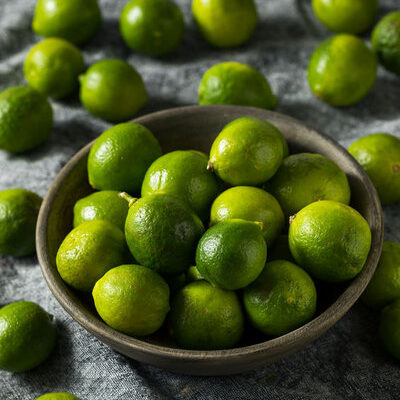
Key Lime
also known as Mexican lime, West Indian lime, Omani lime, Bartender’s lime
What is Key Lime?
Key lime (citrus aurantifolia) is a species of lime, also known as Mexican lime, West Indian lime, Omani lime, and bartender’s lime.
- It is a hybrid citrus fruit that usually has a green skin, which becomes yellow when the fruit ripens.
- The skin is smooth and often used to make zest.
Key lime is one of the main lime types and differs from others in being smaller with more acidity, aroma, and seeds, while having a thinner rind. Key limes provide a juice that is sweet and tart, leading them to be used often in desserts and cocktails.
There are multiple ways to enjoy key limes, such as:
- Limeade
- Guacamole
- Ceviche
- Fruit salad
- Soup
- Switch lemon recipes to limes
- Sparkling water
- Salsa
- Fish
- Yoghurt
Origin of key lime
Limes likely originated in northern India and Myanmar, or in Malaysia. Arab traders and crusaders transported the lime around the known world. Europeans and Africans had already started to consume limes by the 13th century. Spanish and Portuguese colonists took the lime to the Americas, while British colonists most likely brought it to Australia. Today, limes are grown throughout the tropics and in other warm regions.
Nutrition
Limes have a high concentration of vitamin C, which helps keep the immune system healthy. Other nutrients that limes contain include iron, calcium, vitamin B6, thiamine, and potassium. Lime juice also provides antibacterial, antioxidant, and phytochemical properties, which are excellent for good health. In addition, lime can help protect the heart, liver, bone, as well as prevent urinary diseases.
A medium lime (67g) contains the nutritonal value of:

Commercial production
Key limes require hot summers for the best crops and grow best in tropical climates. The tree of the key lime is thorny with little foliage. Key limes are often plucked raw because they tend to spoil very fast. They must be stored in the refrigerator and it is best to use them within two days of purchase.
Mexico and Brazil are the largest producer of limes, including key lime. Limes are usually grouped together with lemons for classification reasons, as they are both closely related citrus species. Another difficulty in taxonomic classification of limes is that this is a species that easily produces hybrids. The top five countries producing limes and lemons are China, India, Mexico, Argentina, and Brazil. The global market for limes and lemons in 2016 reached 17.5 million tons.
Key lime recipes
This lime is a flavorful addition to any dish. It can be used in desserts as well as to jazz up a main dish. Here are a few recipes using key limes:
- Key Lime Pie
- Ice Cream
- Trout
- Guacamole
- Yogurt Parfait
- Lime Cracker Custard Pie
- Lime Martini
- Key Lime Cake
- Tarts
- Pisco Sour
- Pancakes
- Sugar Cookies
FDA regulations
The FDA classifies limes as fruits under the umbrella term of raw agricultural commodity. The growing, harvesting, packing, and storage of limes are strictly regulated. Key limes do not currently have specific regulations.
References
Global Lemon And Lime Market Overview 2020, Indexbox
https://www.indexbox.io/store/world-lemons-and-limes-market-report-analysis-and-forecast-to-2020/
Citrus aurantiifolia (lime), Invasive Species Compendium, Centre of Agriculture and Biosciences International (CABI)
https://www.cabi.org/isc/datasheet/13438
Narang, Nithithep, and Wannee Jiraungkoorskul. “Anticancer Activity of Key Lime, Citrus aurantifolia.” Pharmacognosy reviews vol. 10,20 (2016): 118-122. doi:10.4103/0973-7847.194043
https://www.ncbi.nlm.nih.gov/pmc/articles/PMC5214556/
Kristy Plattner, Fruit and Tree Nuts Outlook: Economic Insight, Fresh-Market Limes, Economic Research Service, United States Department of Agriculture https://www.ers.usda.gov/webdocs/outlooks/37059/49132_fresh-market-limes-special-article.pdf?v=5375.7
